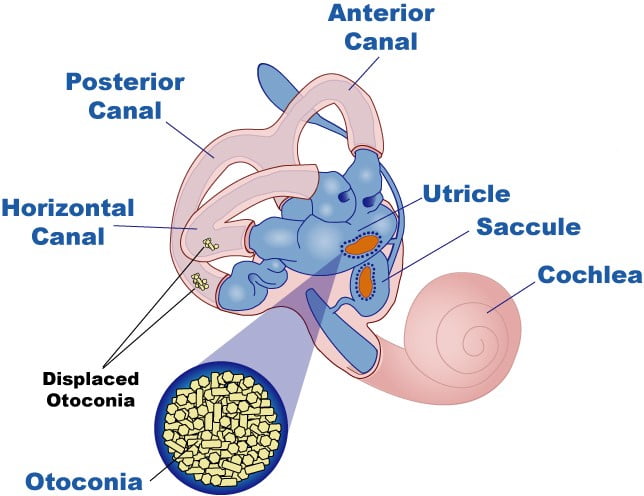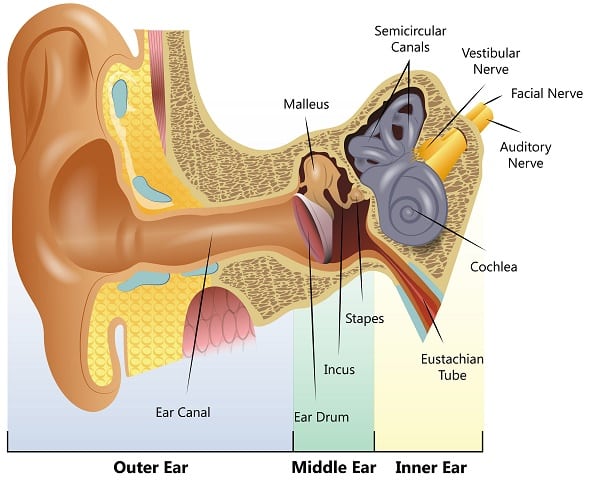Understanding BPPV (Benign Paroxysmal Positional Vertigo): what are the crystals in my ear, and how did they fall out?!
First of all, let me paint a picture so you can visualize this better.
The Vestibular Apparatus, which includes the semicircular canals (senses head movement) and the cochlea (hearing organ), is the purple thing in the photo above. This system is encased deep in your skull and is the size of a dime, and it plays an extremely important role in helping you maintain your balance. It is constantly sending signals to your brain telling it where your head is in space so you don’t fall or lean over to far.
Vertigo is a type of dizziness characterized by a sensation of spinning or motion. It can be described as feeling like you are spinning, or that the world around you is spinning or moving.
The most common cause of vertigo is Benign Paroxysmal Positional Vertigo (BPPV), which is the false sense of spinning you get with certain movements or positions.
Benign means not life threatening.
Paroxysmal means sudden brief spell.
Positional means this type of vestibular disorder is triggered by certain body or head movements.
Vertigo means a false sense of rotational movement.
If you or someone you know has or has had BPPV, you know this can be one of the most horrible experiences! Good news though, it is very simple to fix! Unlike other vestibular disorders, BPPV is a mechanical problem, meaning it can be fixed with a specific procedure done in clinic.
How Does BPPV Happen?
BPPV occurs when some of the calcium carbonate crystals in your inner ear fall out of place. When enough of these crystals fall out of their normal position, it affects the normal fluid movement in these canals which are used to sense head movements, causing the inner ear to send very wrong and alarming signals to the brain.
The most common example of this would be when you roll over in bed. If you have BPPV, the crystals that are out of place will cause the fluid to move around when you roll over, which will send a DANGER signal to your brain because your inner ear is telling your brain; YOU ARE SPINNING ON A MERRY-GO-ROUND BE CAREFUL!! You’ll feel the sensation of vertigo during this episode, which typically lasts about 60 seconds.

What Causes BPPV?
It is not entirely clear what causes BPPV, but there have been links made with head trauma, migraine, ear surgery, aging, diabetes, osteoporosis, prolonged intubation, and people who ALWAYS sleep on one side. Certain medical conditions, such as ear infections or Meniere’s disease, can also increase the risk of developing BPPV.
How BPPV Diagnosed?
Diagnosis of BPPV is made using VNG (videonystagmography) Goggles which utilize infrared cameras that allow the therapist to see your eye movements in a zero-light environment. They will bring you into certain positions, which will trigger an episode. During the episode, nystagmus (very specific eye movements) will occur, which will inform the therapist that you have BPPV and which canal it is in.
How Is BPPV Treated?
BPPV (Benign Paroxysmal Positional Vertigo) can be effectively treated through a procedure called the Epley Maneuver, which is a form of repositioning therapy. During the Epley Maneuver, the patient is positioned in a specific way to allow the displaced otoconia (those pesky crystals) to be repositioned back into their proper location within the inner ear. There are a total of 6 canals in your inner ears, and each canal can be affected with BPPV. There are very specific crystal repositioning maneuvers that will need to performed depending on what the therapist sees during examination. These maneuvers help guide the crystals back into their proper place. Each of these maneuvers only takes about 4 minutes to perform!
After the Epley Maneuver, patients are often advised to avoid any sudden head movements for the next 24 to 48 hours, as this can disrupt the repositioning process. Some patients may require multiple treatments to fully resolve their symptoms. In addition to the Epley Maneuver, vestibular rehabilitation exercises may be prescribed to help improve balance and reduce dizziness.
It is important to note that while the Epley Maneuver is highly effective in treating BPPV, it may not be suitable for everyone. Patients with certain medical conditions or who are unable to tolerate the required head movements may not be able to undergo the procedure. In these cases, alternative treatments may be recommended by a healthcare professional.
If you think you may be suffering from BPPV, Carly our certified vestibular therapist would be happy to guide you through recovery and get back to the things you love! You can give us a call, book online, or email us.

